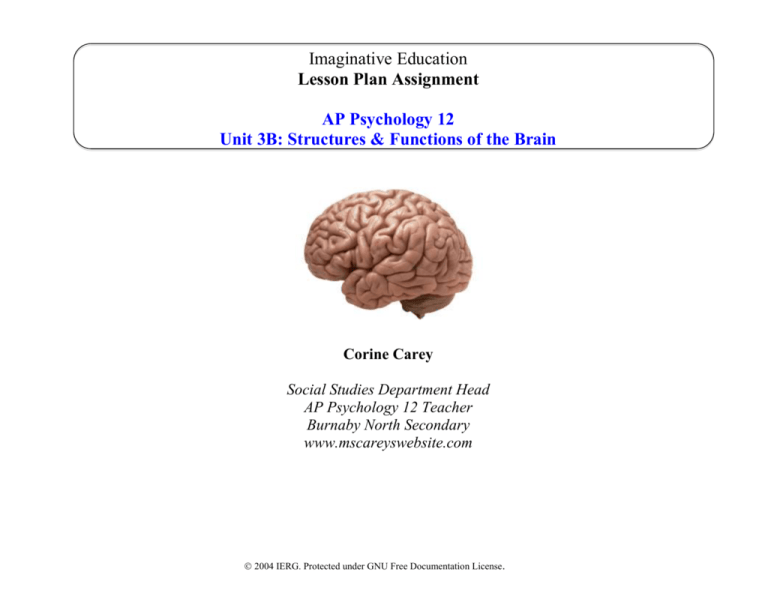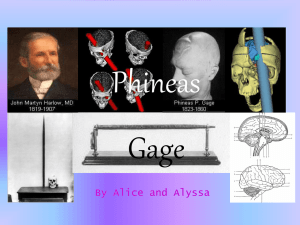The Brain
advertisement

Imaginative Education Lesson Plan Assignment AP Psychology 12 Unit 3B: Structures & Functions of the Brain Corine Carey Social Studies Department Head AP Psychology 12 Teacher Burnaby North Secondary www.mscareyswebsite.com 2004 IERG. Protected under GNU Free Documentation License. Romantic Framework Topic: THE BRAIN: AP Psychology 12 Unit 3B: Structures and Functions of the Brain Finding a Narrative – The Story of Phineas Gage (1848) 2004 IERG. Protected under GNU Free Documentation License. By: Corine Carey Heroic Qualities Heroic Image What “heroic” qualities or values are central to the topic? What makes the characters in this story full of wonder? What image captures the heroic qualities of the topic? - Adaptability - the brain is a complex machine and even if pieces do not work or are damaged, your brain can adapt (brain plasticity) - Accountability - the brain structures need to work together in order to work (neural communication) so if a part is damaged or doesn’t process, then the behaviour will change. In the narrative of Phineas Gage, he has an iron rod shoot up through his face and brain. Yet… he stands up after the accident and walks to the medical office. What students wonder: - How can that even happen? (him getting up & walking after that) What parts of his brain were damaged? Did his behaviour change? What abilities did he loose? Did his brain ‘go back to normal’? What about our brains? Headaches? Concussions? Picture of the iron tampering rod with explosive powder. Image of rod in Gage’s skull Picture of Gage after the accident Organizing Content into Story Form What “heroic narrative” will allow us to integrate the content we wish to cover? The Story of Phineas Gage… On September 13, 1848, the then 25-year-old Gage was working as the foreman of a crew preparing a railroad bed near Cavendish, Vermont. He was using an iron tamping rod to pack explosive powder into a hole. Unfortunately, the powder detonated, sending the 43 inch long and 1.25 inch diameter rod hurtling upward. The rod penetrated Gage's left cheek, tore through his brain, and exited his skull before reportedly landing some 80 feet away. Shockingly, Gage not only survived the initial injury but was able to speak and walk to a nearby cart so he could be taken into town to be seen by a doctor. How could he have done this? After months of recovery, he was allowed to go home. Unable to return to his railroad job, Gage held a series of jobs including work in a livery stable, a stagecoach driver in Chile and farm work in California. Popular reports of Gage often depict him as a hardworking, pleasant man prior to the accident. Post-accident, these reports describe him as a changed man, suggesting that the injury had transformed him into a surly, aggressive drunkard who was unable to hold down a job…. His entire personality and behavior changed. His entire personality and behavior changed and his family claimed he was not the same person. 2004 IERG. Protected under GNU Free Documentation License. Developing Cognitive Tools THE BRAIN – Generating Curiousity about the Brain Discussion of what brain injuries we are familiar with today and how they impact people? Personal stories… Concussions (sports related) Discuss the top sports that cause concussions and then examine the symptoms of a concussion. What is happening in your brain to cause these symptoms? What has been damaged? The most common sports for a concussion in 2008: (connect it to them-humanizing) Cycling Football Basketball Playground activities Soccer Headaches and migranes (what causes them and what is happening inside your brain when you get one? We have all had one before so why do we get them?) HOW do we know what causes these to happen? By studying the strutures and functions of all parts of the brain. Discussion and images of interesting facts about the brain: - Einstein’s brain different from other brains (visual images and how it is different) - Weight and size of average brain - An awake brain can power a light bulb (10-23 Watts) - Animal with the largest brain (Sperm Whale) - Animal with the smallest brain (Mouse Lemur) What parts of the topic can students best explore in exhaustive detail? How can students present their knowledge in some systematic form? THE BRAIN LAB: Have the students ‘build a brain’ out of candy parts and an orange. Their collection will be the candy ‘parts’ of the brain that they have to put back together in proper parts. As they go through the orange brain lab, they must answer the lab questions and fill in the diagrams, functions, etc. (they are now surgeons) - They must organize the parts (based on their previous readings, notes, and lessons) and after hearing the story of Phineas Gage, replicate a proper brain. They cannot eat the brain (the reward for building a correct brain) until they answer 5 random brain questions by the ‘head doctor’ (the teacher). They must then hand in their completed lab and can then eat their brains Is your brain a super computer? Extreme technology! (orange and candy). - Then they must do the final written summary - Explore how your brain (see assessment below) refering back to and a computer work Phineas Gage and what happened to his (encoding, storage, and brain/behaviour. - retrieval) and have students create a venndiagram on how their brain is similar or different from a computer. This would lead into a discussion on artificial intelligence and can we create a ‘computer brain’? 2004 IERG. Protected under GNU Free Documentation License. Student-led/open-ended What extremes of reality are related to the topic – biggest, hottest, oldest, richest? Collecting & Organizing Teacher-led/strructured How can students understand the human hopes, fears, passions or struggles that have shaped our knowledge of this topic? Extremes of Reality St Exploring Human Strengths & Emotions What parts would we need for the brain to work? Watson computer. Looking Forward and Concluding Concluding Activities and Assessment for Brain Lab 2004 IERG. Protected under GNU Free Documentation License. Towards Further Understanding A Celebratory Ending Assessment How can the unit develop embryonic forms of Philosophic and Ironic understanding? What cognitive tools characteristic of the disciplines or embodied self-awareness can be introduced here? What is the best way of resolving the dramatic tension inherent in the unit (in this case the lesson)? What communal project or activity will enable the students to experience and share this resolution? How can one know whether the topic has been understood, its importance grasped and the content learned? Start to poke holes in what they know about the brain and get them thinking about more specific psychological behaviours and links to the brain: What causes fear? (amygdala) Why do some people ‘freeze’ in an emergency? What is happening in your brain? (Fear Response) Why does behaviour change when you are attracted/flirting with someone? What happens when your body goes into shock? (Gate Control Theory) What causes anger? Aggression? Stress? Why do people ‘think’ differently? (How people process and interpret info differently) THE ORANGE LAB: Building the Orange Brain (they become surgeons) and then eating the candy/orange (parts of the brain) when they get the correct answers on their lab/discussion questions. This is only a lesson (over 1-2 days) and the assessment pieces are: FINAL SUMMARY WRITTEN ACTIVITY: Now that they have learned the key parts/structures and functions of the brain, we will revisit the Phineas Gage story and the students then write a ‘final report’ explaining what parts of his brain were damaged and why his behaviour changed after the accident. (wrap up summary activity) This will set up the next unit which is Emotion and Stress. R E F 2004 IERG. Protected under GNU Free Documentation License. 1) The Brain Lab are all sections complete and correct are the diagrams clearly labelled are the functions correct 2) The Final Written Piece: * The summary of Phineas Gage and the students ability to attempt to identify key parts of the brain that were damaged and how that affected his behaviour after the accident. * This will let me know if they understand the structural parts that were damaged AND how their function was impaired and therefore affected his behaviour. F i n a l R e f l e c t i o n Q u e s t i o n s t h a t 2004 IERG. Protected under GNU Free Documentation License.







